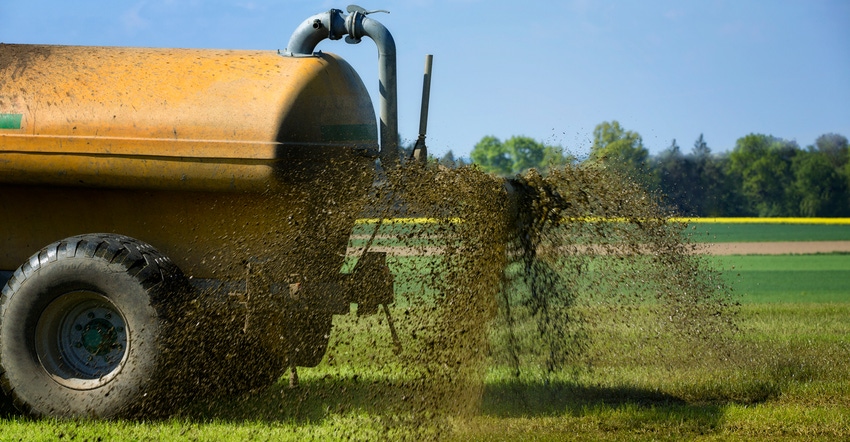May 11, 2021

Manure has a way of agitating people. Whether because of its odor, the possibility that it can attract pests or contaminate resources, or a host of other reasons, manure is a common source of conflict. Nuisance lawsuits such as those filed in North Carolina by neighbors to Smithfield/Murphy-Brown hog operations offer proof that manure can stir up significant legal controversy.
Manure is one reason why all 50 states in the U.S. have a “right-to-farm” law. These laws can shield farmers from liability for nuisance claims. Legally, a “nuisance” is an unreasonable interference with public health or with a private right to use and enjoy property. Because right-to-farm laws can help shield farmers from liability over manure-based nuisance complaints, it’s important for farmers who work with manure to understand their own state’s law and be prepared to qualify for its protection.
A little background
Right-to-farm laws are an outgrowth of a famous lawsuit against a cattle feedlot operator in Arizona. The development company that filed the lawsuit claimed the nearby feedlot created a nuisance for thousands of homes in its Sun City residential development. The Supreme Court of Arizona noted that despite the feedlot’s lawful operation and good management practices, odors and flies did interfere with residents’ enjoyment of the outdoors.
But the court also pointed out that the feedlot existed first, and the developer had created the nuisance problem by “coming to the nuisance.” The court shut down the feedlot, but it forced the developer to pay for relocating it further from the residential area.
After the Arizona case, state legislatures embraced the “coming-to-the-nuisance” theory and enacted right-to-farm laws. These laws vary from state to state, but they generally prevent neighbors from successfully claiming that preexisting farm activities are a nuisance.
Farmers are required to follow applicable laws and use best management practices. There is a recognition that farmers can’t completely prevent all nuisance effects from farming activities. If a farmer meets the state’s right-to-farm provisions, a nuisance claim against the farmer usually won’t survive.
Ensuring you’re protected
How can a farmer ensure they are protected via the right-to-farm law? Here are some guidelines:
Know the time requirements. Nearly all right-to-farm laws establish a period that a farm or farm activity must exist to qualify for legal protection. Some laws simply protect all farms or farming activities that were in place before the complaining party came to the area. Others protect only those activities conducted beyond a certain period of time, such as a year.
Know if an affirmative action is required. Some states require a farmer to do something first to qualify for the right-to-farm protection. A farmer might have to enroll in a specific program, obtain an approved nutrient management plan or receive a certification.
Follow laws and permits. Most states don’t protect an activity that isn’t conducted according to all applicable laws or permits. For example, if state regulations establish a property line setback for manure applications, violating the setback will remove right-to-farm protection. A state’s right-to-farm law doesn’t replace other legal compliance requirements.
Be a good manager. Right-to-farm laws recognize that farmers can’t completely control odors, pests or other nuisance effects, but the laws expect farmers to do their best to reduce those effects. Requirements to use best management practices, generally accepted agricultural practices and to comply with a nutrient management plan are common in right-to-farm provisions.
Keep records. A farmer should maintain thorough records that can prove eligibility for right-to-farm protection and document manure management practices.
Work with an agricultural attorney. An attorney who understands both the right-to-farm law and the farming operation can guide actions that will ensure protection from nuisance liability.
Consider getting insurance. Even with right-to-farm protections in place, other strategies are necessary to minimize nuisance risk from manure-related activities.
Insurance is always a solid risk management tool, and a tailored policy or addendum can address coverage for manure. If the landowner and manure applicator are different parties, a well-written contract can address nuisance liability.
Good neighborly practices such as educating non-farmers and being mindful about when to apply manure can reduce negative reactions from neighbors. If nuisance conflicts do arise, detailed records also can prove helpful.
Manure activities are likely to raise a few eyebrows and a few complaints. Farmers working with manure can be prepared for the conflict by understanding their state’s right-to-farm law.
To find your state’s right-to-farm statute, visit the National Agricultural Law Center’s compilation of state statutes at nationalaglawcenter.org.
Hall is an associate professor of agricultural law and director of the Ohio State University Extension Agricultural & Resource Law Program.
You May Also Like




